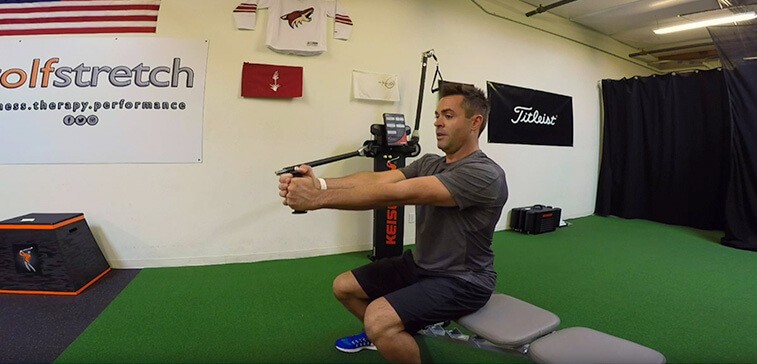
Blog Breakdown:
- I’ve said it once, but I’ll say it again: it’s imperative golfers have a strong core to prevent injuries to their lower back.
- While traditional crunches can help build a stronger core, people should perform other exercises to challenge different parts of their abdomen.
- In this blog, Golfstretch CEO Adam Swanson demonstrates a golf exercise for the core called “lateral resisted sit to stand.”
The abdominal wall is a complex structure that is made up of five different muscles, so it’s important golfers give this part of the body the attention it deserves before stepping on the green. I wrote a blog about working your internal obliques for better rotation and increased power, which you can read here: https://www.golfstretchtherapies.com/2016/06/10/internal-oblique-dips-to....
The external and internal obliques, as well as the transversus abdominis, are three flat muscles that make up the lateral abdominal wall. They work together to laterally flex and rotate the trunk of your body (core), which comes in handy when you swing your golf club. The fibers of these muscles (i.e. external obliques, internal obliques, and transversus abdominis) run in different directions and cross one another, so strengthening this part of the abdominal wall could decrease your risk of herniation.
Regardless, performing traditional crunches will only do so much to strengthen your core. In fact, crunches are limiting because they only work the vertical muscles in your abdomen, which include the rectus abdominis and pyramidalis. That’s why it’s important for you to implement other core exercises to challenge nearby structures. In this blog and corresponding video, I demonstrate a unique core exercise that works all of the muscles in your lateral abdominal wall. It’s called the lateral resisted sit to stand.
This exercise actually works other muscle groups as well, like the glutes and quads from the sitting and standing motions. Nevertheless, the focus of this golf exercise is to strengthen the lateral abdominal muscles. For the best results, you’ll want to use a functional trainer that has weight stacks. If you don’t belong to a gym or you’re on a budget, try attaching a resistance band to a spot on your living room wall. You’ll also need a chair or bench to perform this exercise as well.
As you can see in the video, I start this exercise sitting on a workout bench. You’ll want to do the same after you’ve entered the proper weight requirements on your functional trainer. I recommend setting your weighted stack anywhere from 6 to 12 lbs. to get a good workout in without injuring your lower back. If you feel you need more of a challenge, increase the weight.
Lateral Resisted Sit To Stand
To begin, roll your pelvis forward, activate your core, and grab hold of the cable. Pull your resistance band directly in front of you with your arms locked in a straight position. In this position, you should already feel your core engaged. Next, you’ll want to stand, hinge from the hip, and then sit back down. It’s crucial you perform the “hinge” part of this exercise so you’re not rounding your back. Rounding the back transfers the engagement from your abs to your lower back, which can cause damage.
Give this exercise a try in your next workout and let me know what you think!
Golfstretch is a sports performance and rehabilitation center located in Scottsdale, Arizona. Utilizing a combination of therapies, the team at Golfstretch helps clients achieve their health and fitness goals. To learn more about golf fitness, stretch therapy, corrective exercise, and more, call 480-269-1119 to schedule a consultation today! We look forward to hearing from you!
The advice and information contained in this article is for educational purposes only and is not intended to replace or counter a physician’s advice or judgment. Please always consult your physician before taking any advice learned here or in any other educational medical material.
